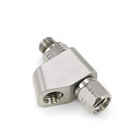That wye shaped one might go nicely with that small digital console....
You are using an out of date browser. It may not display this or other websites correctly.
You should upgrade or use an alternative browser.
You should upgrade or use an alternative browser.
Adding HP Port onto 1st Stage (Cressi XS Setup)
- Thread starter etxtacoma
- Start date
Please register or login
Welcome to ScubaBoard, the world's largest scuba diving community. Registration is not required to read the forums, but we encourage you to join. Joining has its benefits and enables you to participate in the discussions.
Benefits of registering include
- Ability to post and comment on topics and discussions.
- A Free photo gallery to share your dive photos with the world.
- You can make this box go away
Youngsters! Bragging that they can focus their eyeballs on a gauge on their chest. I can't even bend my neck that far, lol!I however rout it over my shoulder and it is captured in my chest rings...
etxtacoma
Registered
I use this adapter
View attachment 867643
on an 18" HP hose, bolt snapped to a waist D-ring. I add a button gauge for a pony to the top port, and the transmitter to the end port.
Advantages:
- my transmitter never gets grabbed as a handle when diving from a panga and they haul your rig out
- both I and the boat crew can see my tank pressure without my computer being on, if you're "valet diving" and they set up your gear for you, or if my transmitter fails
- biggest advantage is that I no longer get occasional signal drop out from a transmitter that's hidden by my metal tank and first stage behind my head, while my computer is on the opposite side on an extended arm.
Disadvantage:
- extra failure point, mitigated by that tiny HP hole in the first stage, which will keep gas loss to a minimum.
@Endler's , I can't remember where I bought the manifold block...
Trident S137 High pressure splitter
Much appreciated on the info! Sounds like a good route to go with even having the button gauge on there!I too use the block that @rsingler discussed above. I however rout it over my shoulder (it up under my armpit) and it is captured in my chest rings. Button gauge is easily there to see either kitting up or if there is an issue when splashed. As a plus, the transmitter is well protected but right there with wrist unit, even with my ape-length arms...
Similar threads
- Replies
- 5
- Views
- 737
- Replies
- 29
- Views
- 3,095
- Replies
- 6
- Views
- 660
- Replies
- 4
- Views
- 1,104




